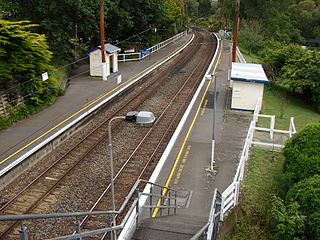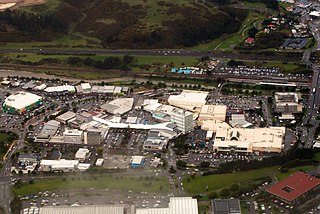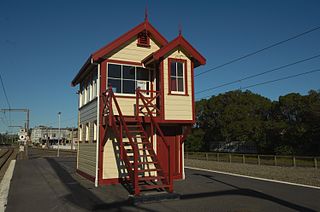Related Research Articles

The North Island Main Trunk (NIMT) is the main railway line in the North Island of New Zealand, connecting the capital city Wellington with the country's largest city, Auckland. The line is 682 kilometres (424 mi) long, built to the New Zealand rail gauge of 1,067 mm and serves the large cities of Palmerston North and Hamilton.

Public transport in the Wellington Region, branded under the name Metlink, is the public transport system serving Wellington and its surrounding region. It is the most used public transport system in New Zealand per capita, and consists of electric and diesel buses, suburban trains, ferries and a funicular. It also included trams until 1964, and trolleybuses until 2017.

The 8.38 miles (13.49 km) Tawa Flat deviation is a double-track section of the Kapiti Line just north of Wellington, New Zealand, with two tunnels; the southernmost section of the North Island Main Trunk railway (NIMT) between Wellington and Auckland. It was built to bypass a limited capacity single track section of the original Wellington and Manawatu Railway (WMR) line which ascended from Wellington to Johnsonville and then descended to Tawa Flat. The original name of Tawa Flat was changed to Tawa in 1959.

Metlink's Kapiti Line is the electrified southern portion of the North Island Main Trunk railway between New Zealand's capital city, Wellington, and Waikanae on the Kāpiti Coast, operated by Transdev Wellington on behalf of Greater Wellington Regional Council. Trains run frequently every day, with stops at 16 stations. Until 20 February 2011 it was known as the Paraparaumu Line.

Takapu Road railway station is on the suburban rail network of Wellington, New Zealand, on the Kapiti section of the North Island Main Trunk Railway (NIMT). It is double tracked with side platforms. It serves the suburbs of Redwood and Grenada North, and the rural Takapu Valley.

Redwood railway station on the suburban rail network of Wellington, New Zealand, is on the North Island Main Trunk Railway (NIMT). Opening in late 1963, it is double tracked with staggered side platforms; the up platform is on the north side of the Tawa Street level crossing, the down platform on the south. The station serves the suburb of Redwood.

Tawa railway station, originally called Tawa Flat, is on the North Island Main Trunk Railway (NIMT) and is part of the suburban rail network of Wellington, New Zealand. It is double tracked with an island platform, and is 13.75 kilometres (8.54 mi) from Wellington railway station, the southern terminus of the NIMT. The station serves the suburb of Tawa.

Kenepuru railway station is on the North Island Main Trunk Railway (NIMT) in New Zealand, on Wellington's suburban rail network. It is double tracked with side platforms on a curved section of the line, 16.16 km from Wellington railway station, the southern terminus of the NIMT. The station serves the industrial suburb of Kenepuru and is within walking distance of Kenepuru Hospital.

Khandallah railway station is one of eight stations on the Johnsonville Line, a commuter branch railway north of Wellington in New Zealand’s North Island. The station was erected and operated by the Wellington and Manawatu Railway Company (WMR) on their line from Wellington to Longburn. From the acquisition of the WMR by the New Zealand Railways Department in 1908 until the opening of the Tawa Flat deviation in 1937, the station was on the North Island Main Trunk Railway.

Johnsonville railway station is the terminus of the Johnsonville Line, one of eight stations on the commuter branch railway north of Wellington in New Zealand’s North Island. It serves the suburb of Johnsonville, and as a bus interchange attracts traffic from other suburbs to the north and east.

Pukerua Bay railway station is located on the North Island Main Trunk Railway (NIMT) in Pukerua Bay, New Zealand and is part of the suburban rail network of Wellington. It is double tracked, has an island platform layout, and is 30.4 km from Wellington railway station, the southern terminus of the NIMT. It is one of two railway stations in Pukerua Bay, the other one at Muri being closed.
Plimmerton railway station is on the North Island Main Trunk Railway (NIMT) in Plimmerton, Porirua, New Zealand, and is part of Wellington's Metlink suburban rail network operated by Transdev Wellington. It is double tracked around a long island platform, with subway access from Steyne Avenue and Plimmerton Domain's Park and Ride to the north, and a controlled crossing to Steyne Avenue and Mainline Steam at the south end of the platform. Mainline Steam, a heritage steam train restorer and operator, is located in the former goods yard next to the station.

Paremata railway station on the Kapiti Line section of the North Island Main Trunk Railway (NIMT) in Paremata in the city of Porirua, New Zealand, is part of the Wellington Region's Metlink suburban rail network.

Porirua railway station is an important intermediate station in New Zealand on the Kapiti Line from Wellington and is part of Wellington's Metlink suburban rail network operated by Transdev Wellington.

Mana railway station on the Kapiti Line section of the North Island Main Trunk Railway (NIMT) in the locality of Mana in the Paremata suburb of the city of Porirua, New Zealand is part of Wellington's Metlink suburban rail network.

Paekakariki railway station in Paekākāriki on the Kāpiti Coast, New Zealand, is an intermediate station on the Kapiti Line for Metlink's electric multiple unit commuter trains from Wellington. Paekākāriki was the terminal station of the commuter service from 1940 to 1983, when the service was extended to Paraparaumu, and to Waikanae in 2011.
Paraparaumu railway station in Paraparaumu on the Kāpiti Coast, New Zealand is an intermediate station on the Kapiti Line section of the North Island Main Trunk for Metlink's electric multiple unit commuter trains from Wellington. Paraparaumu was the northern terminal for Kapiti Line services from 7 May 1983 until 20 February 2011 when the electrification and Kapiti Line services were extended to Waikanae.
Waikanae railway station in Waikanae on the Kāpiti Coast, New Zealand, is the terminal station on the Kapiti Line for Metlink's electric multiple unit commuter trains from Wellington. The railway is part of the North Island Main Trunk line that connects Wellington and Auckland.

The Wellington and Manawatu Railway Company was a private railway company that built, owned and operated the Wellington-Manawatu railway line between Thorndon in Wellington, the capital of New Zealand, and Longburn, near Palmerston North in the Manawatu, between 1881 and 1908, when it was acquired by the New Zealand Government Railways. Its successful operation in private ownership was unusual for early railways in New Zealand.

The North–South Junction is a section of single-track rail line about 7 km long, north of Wellington, New Zealand between the closed (2011) Muri railway station and the (lower) Paekakariki railway station to the north. It is part of the Kapiti Line section of the North Island Main Trunk line between Wellington and Auckland, and part of the Wellington–Manawatu Line, built by the Wellington & Manawatu Railway Company (WMR).
References
- 1 2 3 "Kapiti Line (Waikanae – Wellington) – Metlink". www.metlink.org.nz. Retrieved 21 December 2019.
- ↑ metlink, Paraparaumu Line timetable Archived 11 October 2007 at the Wayback Machine , accessed 30 October 2007.
- ↑ metlink Kapity Train Line timetable effective from 20 January 2016
- ↑ John Yonge (editor), New Zealand Railway and Tramway Atlas, fourth edition (Essex: Quail Map Company, 1993), 16.
- ↑ Murray (2014), p. 154
- ↑ Murray & Parsons (2008), p. 33
- ↑ Cassells, Ken R. (1988). Tawa: Enterprise and Endeavour. Wellington: Tawa Borough Council. pp. 60–62.
- ↑ Murray (2014), p. 228
- ↑ "Wellington railway station bridge closed due to quake risk". Stuff (Fairfax). 10 January 2019. Retrieved 12 January 2019.
- ↑ Murray & Parsons (2008), p. 36
- Rails through the Valley: The story of the construction and use of the railway lines through Tawa by Bruce Murray and David Parsons (2008, Tawa Historical Society) ISBN 978-0-473-14410-4
- Murray, Bruce (2014). A History of Tawa. Wellington: Tawa Historical Society. ISBN 978-0-473-25848-1.